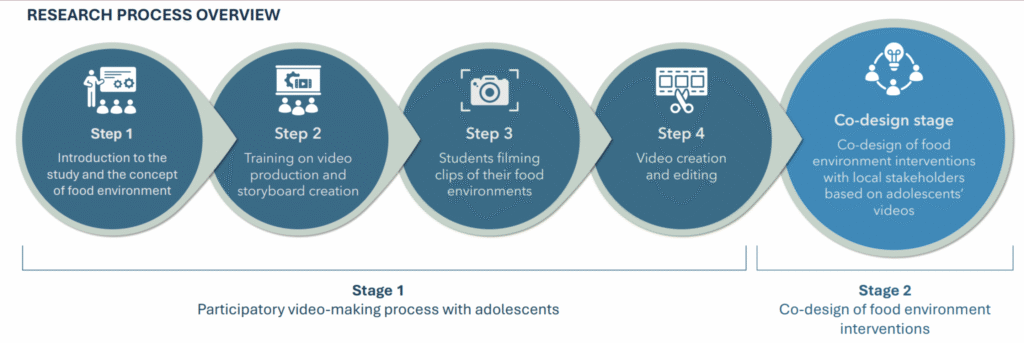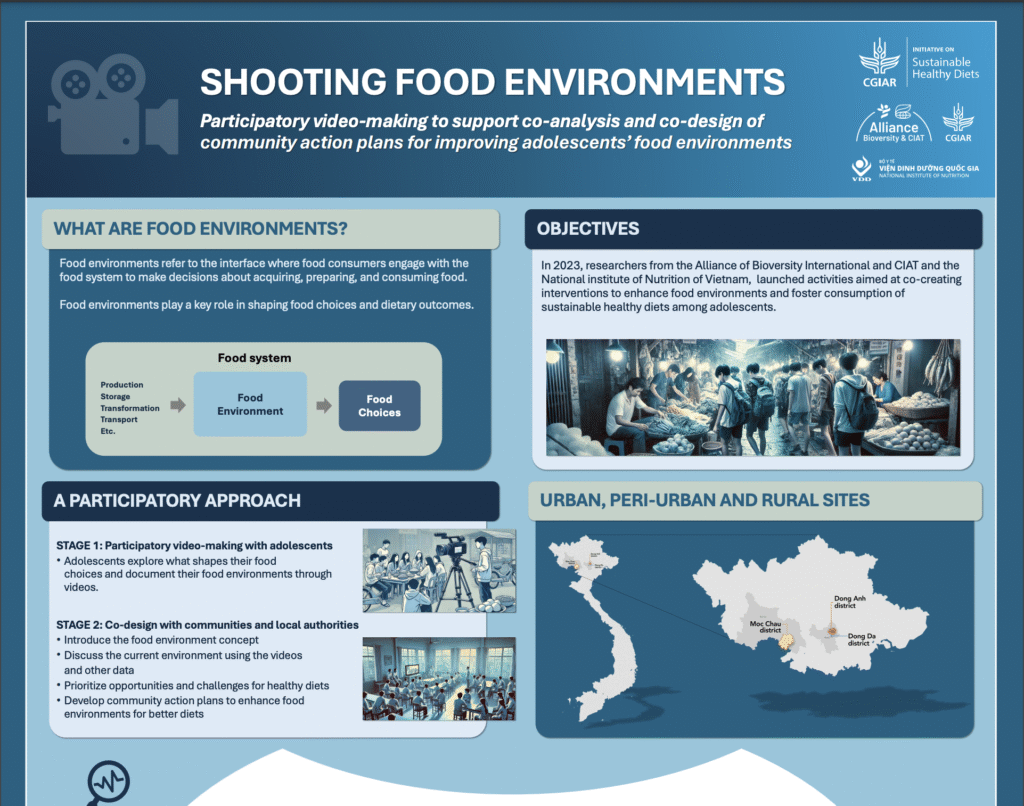PV Project Shows How Youth Navigate Food Environments In Vietnam
PV Project Shows Food Environments in Vietnam
In 2023, the Alliance of Biodiversity International Center for Tropical Agriculture (CIAT) conducted a PV study in partnership with the National Institute of Nutrition of Vietnam. The project involved 54 adolescents (aged 15-17) from three districts: Moc Chau (rural), Dong Anh (peri-urban), and Dong Da (urban). Divided into six gender-specific groups, the participants used PV to document their interactions with their food environments.
Project Background and Rationale
This PV case study is part of CGIAR’s new research initiative, Sustainable Healthy Diets through Food Systems Transformation (SHiFT). It focuses on promoting access to sustainable healthy diets for everyone by boosting both the demand for such diets and the availability of nutritious, sustainable foods. It also aims to enhance livelihoods, advance gender equality, and foster social inclusion across all areas of the food system.
The project explores how PV empowers youth in Vietnam to analyze and improve local food environments. This approach fosters collaboration among adolescents, communities, school, and governments to address challenges related to food access, nutrition, and health outcomes.
Target Audience
The study seeks to influence multiple levels of stakeholders by using youth-generated evidence to advocate for healthier, more inclusive food systems.
- Youth and Adolescents: As both participants and beneficiaries, young people are central to study. The project empowers them to reflect and influence their food environments through particularly video-making.
- Local Communities: The video and findings are intended to raise awareness within the adolescent’s own communities (including families, neighbors, and local leaders) about the realities of youth food access and nutrition challenges.
- School and Educators: Teachers, school administrators, and school food program coordinators are key stakeholders, particularly where interventions (e.g., healthier school meals, nutrition education) are needed.
- Government and Policymakers: Especially those involved in health, education , agriculture, and youth affairs, to inform policies and interventions that promote equitable and nutritious food environments.
Objectives
- Empower youth to analyze and reflect on their food environments: By engaging young people directly through participatory video-making, the project aims to give them tools to explore, document, and interpret the factors that influence their daily food choices.
- Understand how adolescents interact with food systems: The study investigates the real-world food environments of adolescents in Vietnam, focusing on where they access food (e.g., street vendors, school canteens, convenience stores, home gardens) and what influences their food decisions (e.g., price, convenience, taste)
- Identify challenges and opportunities for improving food environments: Through the perspectives of youth, the project uncovers issues like limited access to nutritious food, water scarcity, reliance on processed foods, and food security. It also identifies possible solutions at community and policy levels.
Implementation Plan

The figure demonstrates the research process that was employed in the study. The process involves education and media training to provide the participants with the knowledge and skills to implement a PV project. The participants are also tasked with producing their own videos about their food environments. At the end, they used the videos to co-design interventions with local stakeholders (e.g., school administration and community leaders). It effectively links storytelling with systematic change.
Key Findings & Recommendations of the Project
At the end of the project, the researchers came to conclusion that adolescents in Vietnam navigate complex food environments and that their social environments significantly influence their food choices. Moreover, PV provided the participants with a platform of their voices to be heard and empowered them to engage and collaborate with relevant stakeholders to enact changes in their food environments.
In line with this, the researchers listed out the following opportunities for community action (Even et al., 2023):
- Enhance availability of healthy foods at home and school canteens
- Replace unhealthy food advertisements with healthy food messaging in and around schools
- Improve capacity of adolescents and adults to effectively use nutrition information and food labels
- Strengthen culinary knowledge and skills to prepare nutritious and tasty meals
- Increase community awareness of nutrition and food safety practices
Source

Even, B., Thai, H., Nabuuma, D., Mai, T., & Phuong, N., (2023). Shooting food environments: Participatory video-making to support co-analysis and co-design of community action plans for improving adolescent’s food environment [Poster].
Echeverry, E., Nabuuma, D., Even, B., Gebru, M., & Jordan, I. (2025, March 15). Giving young people a voice to better understand their food environments. Alliance of Biodiversity International and CIAT. https://alliancebiodiversity.org/stories/giving-young-people-voice-better-understand-food-environments
